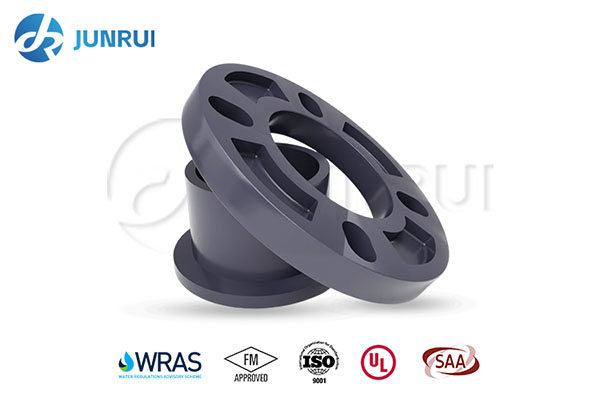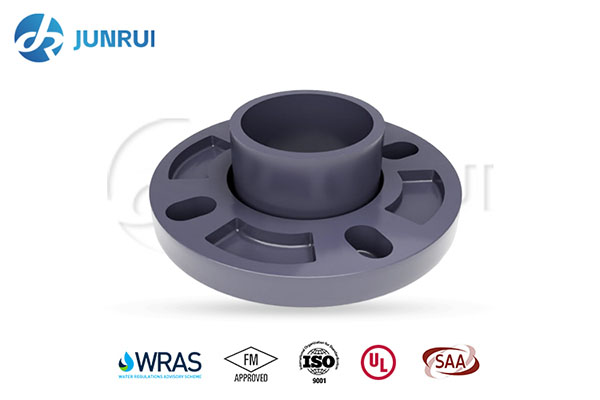PVC Flange
Raw Materials: PVC
Standard: ISO 4427/ EN12201/ AS/NZS 4130/ SANS 4427/ ASTM F714/ ASTM D 3035
Size: 20mm-110mm (Can Be Customized)
Pressure: SDR11-PN16 Bar, SDR13.6-PN12.5 Bar, SDR17-PN10 Bar, SDR21-PN8 Bar, SDR26-PN6 Bar
Certificate: ISO 14001, ISO 9001, OHSAS 18001, CE BS EN 12001 Certification
Contact Us
- +86 15093100892
- inquiry@phtopindustry.com
- No.86 Jingsan Rd, Jinshui District, Zhengzhou City 45000, china
product category
What is a PVC flange?
PVC Flange (polyvinyl chloride flange) is a pipe connector made of high-strength polyvinyl chloride (PVC) material, which is widely used in chemical, water treatment, environmental protection, food, pharmaceutical and other fields. PVC flange has excellent corrosion resistance, lightweight, easy installation and other characteristics, suitable for sealing and connection of low-pressure pipeline systems.
PVC Flange Features
1. Strong corrosion resistance
PVC flange has excellent tolerance to acids, alkalis, salts and various chemical solvents, suitable for the transportation of corrosive media, and has a long service life.
2. Lightweight and easy to install
Compared with metal flanges, PVC flanges are lighter, easier to carry and install, and can greatly reduce construction costs.
3. Good sealing performance
Use rubber gaskets or PVC sealing rings to ensure reliable sealing at the connection to prevent leakage.
4. Economical and practical
The price is lower than stainless steel or carbon steel flanges, with high cost performance, suitable for projects with limited budgets.
5. Good insulation performance
PVC material is non-conductive and suitable for occasions such as electricity and communications that require insulation.
Product specifications
Material: UPVC (rigid polyvinyl chloride), CPVC (chlorinated polyvinyl chloride)
Pressure level: PN6, PN10, PN16 (customized according to needs)
Connection method: flat welding flange, slip-on flange, threaded flange, etc.
Size range: DN20~DN110 (support non-standard customization)
Applicable temperature: -10℃~+60℃ (UPVC), -20℃~+95℃ (CPVC)
PVC Flange Application areas
Chemical industry: acid and alkali liquid transportation, waste gas treatment pipeline
Water treatment: water supply and drainage, sewage treatment system
Food and medicine: pure water, food-grade medium transportation
Environmental protection engineering: waste gas emission, waste liquid recovery system
Construction industry: air conditioning cooling water pipeline, fire sprinkler system
Installation and maintenance
During installation, ensure that the flange end face is clean, the sealing gasket is placed flat, and the bolts are tightened evenly.
Avoid violent installation or overpressure use to prevent flange deformation or cracking.
Check the sealing regularly and replace aging gaskets in time.
Purchase suggestions
Choose the appropriate PVC flange material (UPVC or CPVC) according to the media characteristics, pressure and temperature requirements, and confirm the flange standard (such as national standard GB/T, American standard ANSI, etc.).
Do PVC flanges need gaskets?
Yes, PVC flanges usually require gaskets (sealing pads) to ensure the tightness of the joints and prevent leakage of the medium.
Why do PVC flanges need gaskets?
Filling minor unevenness:
There may be minor processing unevenness on the flange surface, and the gasket can fill the gap and enhance the sealing effect.
Buffering vibration and thermal expansion and contraction:
PVC material may expand and contract when the temperature changes, and the gasket can absorb some of the stress to prevent the flange from deforming or cracking.
Adapting to different media:
The gasket material (such as rubber, PTFE, EPDM, etc.) can be selected according to the characteristics of the medium, corrosion resistance or high temperature resistance.
Common gasket materials
| Material | Properties | Applicable Scenarios |
| NBR Rubber | Oil-resistant, water-resistant | Water, air, weak acid/alkali systems |
| EPDM Rubber | Ozone-resistant, aging-resistant | Hot water, mild acid/alkali environments |
| PTFE (Polytetrafluoroethylene) | Chemical-resistant, high-temperature resistant | Strong acids/alkalis, organic solvent pipelines |
| Silicone | High-temperature resistant, non-toxic | Food, pharmaceutical industries |
Installation precautions
The gasket should be placed flat to avoid folding or offset.
The bolts should be tightened diagonally to ensure uniform pressure distribution and prevent unilateral leakage.
Regularly check whether the gasket is aging or compressed and deformed, and replace it in time.
Exceptions
Some slip-on flanges or PVC flanges with sealing grooves may not require additional gaskets (relying on O-rings or soft sealing structures).
Gaskets can sometimes be omitted for low-pressure non-critical pipes (such as ventilation systems), but it is recommended to retain them to improve reliability.
Product Specification
| Product name | PVC Flange |
| Size available | DN20mm, 25mm, 32mm, 40mm, 110mm |
| Pressure Rating | SDR11,SDR13.6,SDR17,SDR21,SDR26 |
| Material | PVC |
| Color available | White or Grey, or as per request |
| Sample available | Available |
| Joint method | Solvent Cement |




























